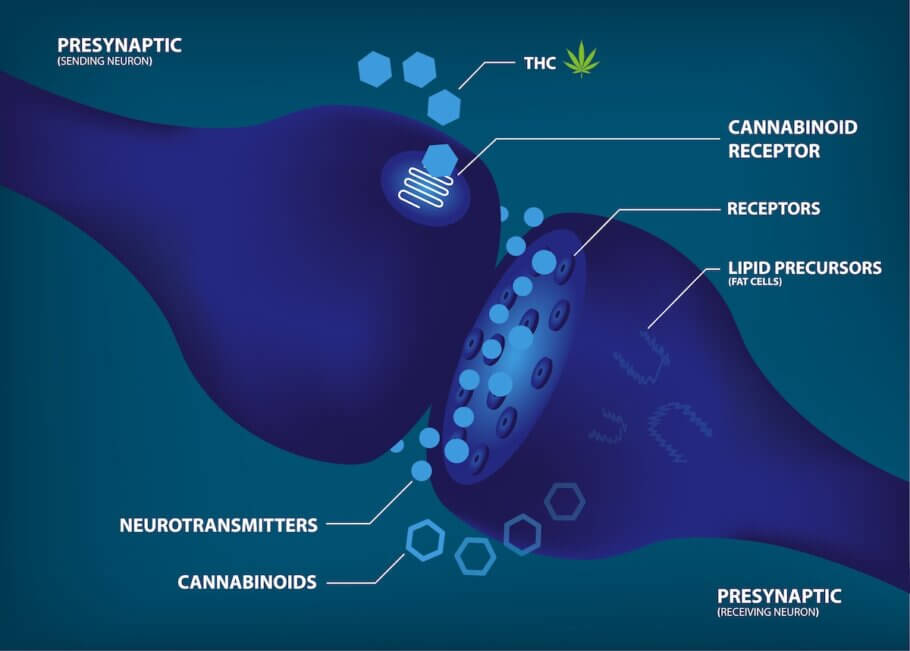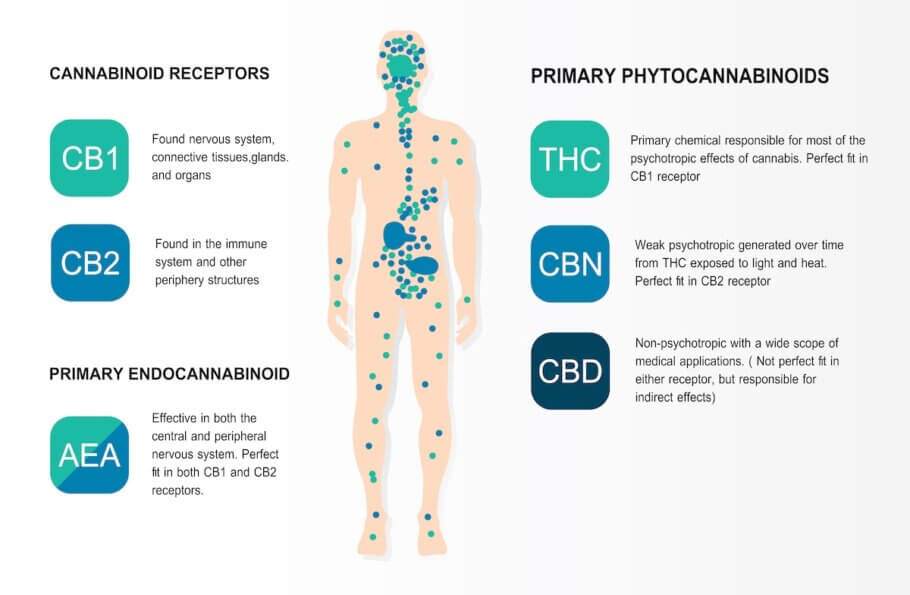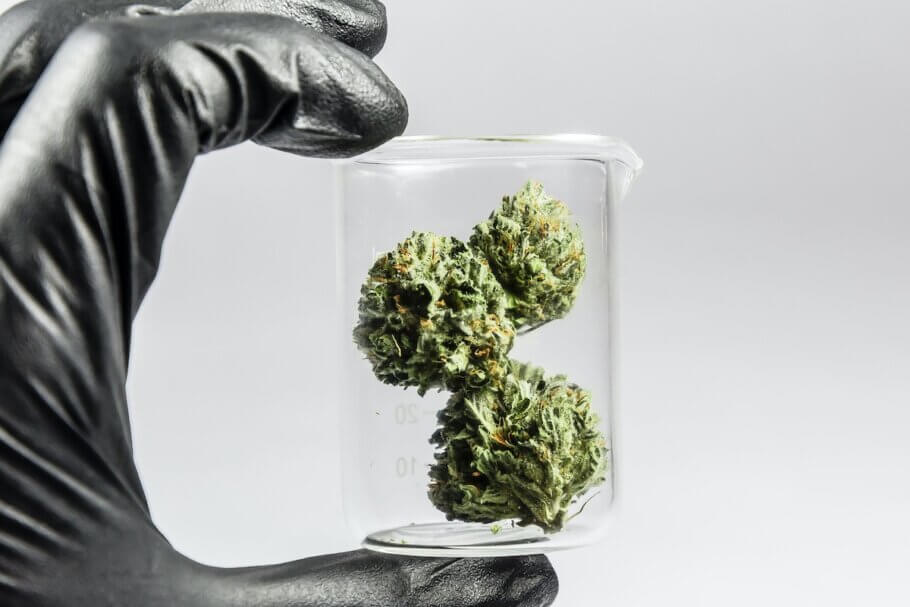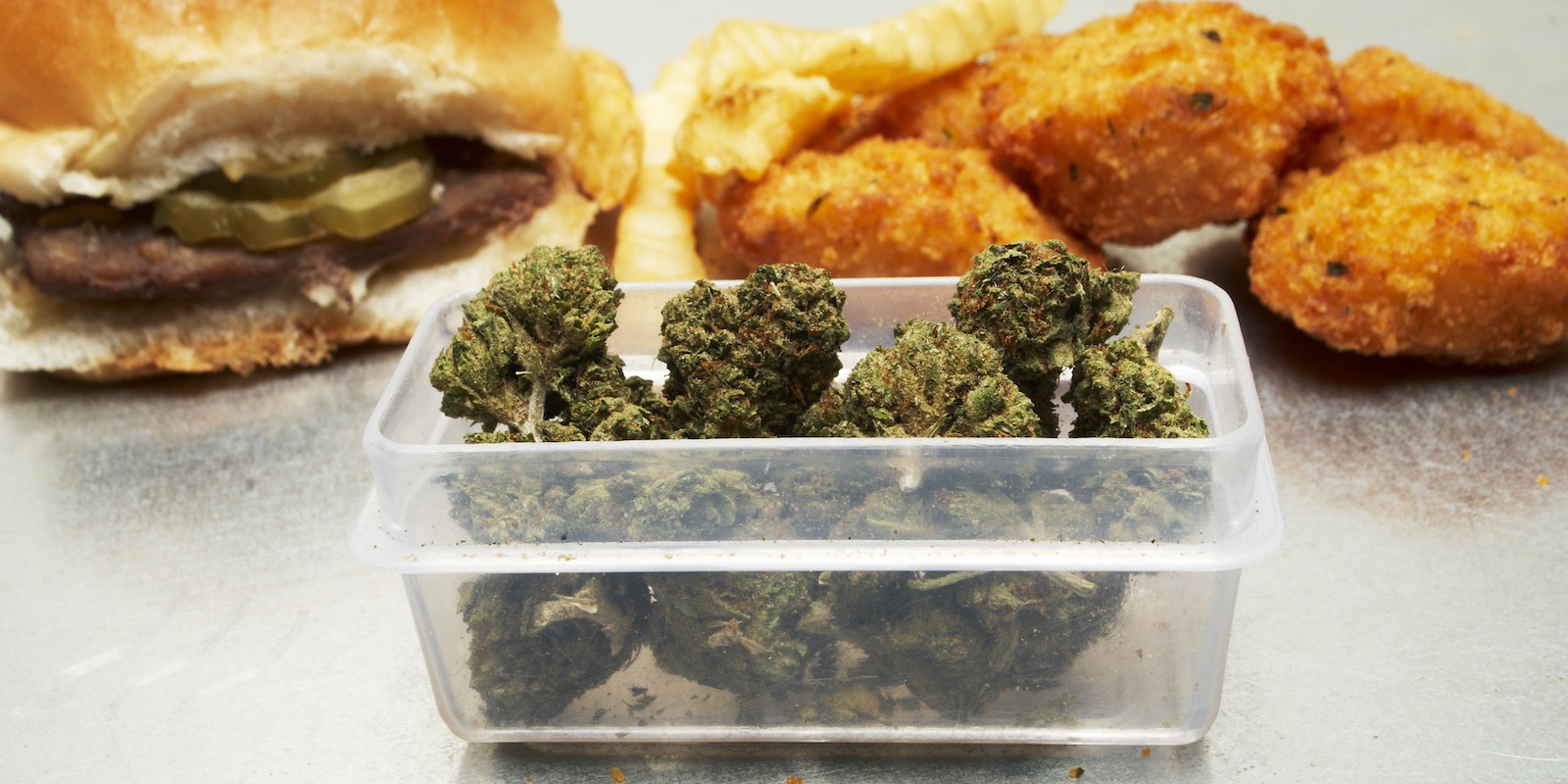What is the endocannabinoid system? (ECS)
List of contents
The endocannabinoid system (ECS) is an intercellular communication system that is made up of endogenous cannabinoid receptors and endocannabinoids (those produced by our own body) and that can also interact with the cannabinoids produced by the cannabis plant (phytocannabinoids).
Cannabinoid receptors are located mostly in the brain and spinal cord (central nervous system), the peripheral nervous system, and in many tissues and organs in our body. These receptors are activated when stimulated by endocannabinoids: their ligands. These molecules fit perfectly with them and allow them to send cellular signals to regulate all kinds of functions in our body. In a similar way, these receptors "listen" to conditions outside the cell and transmit information about those changing conditions to the interior of the cell, initiating the appropriate response.
In this way, the receptors act as a lock on the door of cell signalling, while the endocannabinoids are the key that activates its mechanism. Thanks to this intricate network of "locks and keys" spread throughout our body, the endocannabinoid system acts like an invisible spider running through our body to maintain balance in its functions or homeostasis, biological harmony in response to changes in the environment; and that affects all body systems or their related functions, such as sleep, appetite, pain, inflammation, memory, mood and even reproduction, ensuring that all systems work in coordination with each other.
Thus, every time a health problem occurs, the endocannabinoid system will release its endogenous cannabinoids to restore balance and solve it. However, sometimes it is unable to do the job by itself, which can be the cause of various chronic ailments. And that's where exogenous cannabinoids or phytocannabinoids come into play to restore and improve their signalling.

How was the endocannabinoid system discovered?
Despite its importance in regulating bodily functions, the endocannabinoid system was only discovered 30 years ago, when in 1990 molecular biologist Lisa Matsuda and her team at the National Institute of Mental Health in the United States first identified a THC-sensitive receptor in the brain of laboratory mice.
Scientists were trying to understand how THC, the main psychoactive substance in cannabis, exerted its effects within the body, discovering a remarkably complex network of receptors expressed on cells of the central and peripheral nervous systems: the CB1 cannabinoid receptors. Later, the type 2 cannabinoid receptor (CB2) would also be discovered.
But... why would the body produce these receptors if there were no natural cannabinoids to communicate with them? The discovery of the CB1 and CB2 receptors sparked a search for cannabinoid-like chemicals within the body capable of naturally interacting with these newly discovered receptors: endocannabinoids, natural molecules similar to plant cannabinoids (but produced by the human body) that act as chemical "messengers", helping to coordinate and regulate everything we feel, think, and do.
They began to realise that cannabis exerted its effects, in part, by mimicking our endocannabinoids. To close the loop, scientists also discovered a third fundamental component of this system: metabolic enzymes. Once the endocannabinoids have bound to the cannabinoid receptors and served their signalling purpose, the enzymes of the endocannabinoid system work to break them down, preventing them from accumulating in excess.
Components of the endocannabinoid system
Now that we know what it consists of, let's take a closer look at the components of the endocannabinoid system:
- Receptors: CB1 and CB2 are our cannabinoid receptors. They differ in their distribution in different tissues and in the way they transmit the signal. CB1 is distributed in the central and peripheral nervous system and some organs of the reproductive, urinary and gastrointestinal systems. CB2, on the other hand, is found in immune cells, including leukocytes, the spleen, and the tonsils. Depending on their presence in our body, these receptors will be responsible for regulating one function or another when activated by cannabinoid ligands.
- Endocannabinoid Ligands: These ligands are derived from fatty acids and occur naturally in our bodies. Although there are several of them, anandamide (AEA) and 2-arachidonyl-glycerol (2-AG) are the endocannabinoids par excellence. Both can activate CB1 and CB2 receptors, as well as other cellular proteins and ion transport channels.

In addition, ECS receptors can be activated by binding to phytocannabinoids from the cannabis plant. There are about a hundred of these components, but there are two that take centre stage due to their multiple applications:
- THC: it is the psychoactive cannabinoid of cannabis and generates the famous "high" of marijuana. It is a compound classified as a sedative-hypnotic and has therapeutic applications. Its chemical structure is very similar to anandamide, which allows it to interact with the CB1 and CB2 receptors and activate the signalling pathways of this endocannabinoid.
- CBD: This is a non-psychoactive cannabinoid that has gained popularity in recent years due to its multiple therapeutic properties. Its mechanism of action with the endocannabinoid system is still under investigation since its affinity with the CB1 and CB2 receptors is lower than that of THC. However, it is believed that, in part, its action is due to interaction with cellular ion channels.
What functions does the endocannabinoid system regulate?
From menstrual pain to sleep regulation, the endocannabinoid system is constantly working to bring well-being and balance to our body. Below, we explain some of its key functions that can affect our day to day:
Regulation of menstrual pain
The influence of the endocannabinoid system on endometriosis and menstrual pain is due to the presence of endocannabinoid receptors in the uterus and the digestive tract. It has been observed that the number of CB1 receptors in the uterus is lower in women with endometriosis, so their activity would be necessary to maintain a healthy endometrium. In addition, a depression of the endocannabinoid system, as well as variations in anandamide levels, have been associated with the growth of endometrial tissue and more intense pain during menstruation. This highlights the fundamental role that the endocannabinoid system plays in the female reproductive system, which is why some studies describe endometriosis as a deficiency of the endocannabinoid system.
Libido regulation
The CB1 receptor is found on neurons involved in dopamine and serotonin release pathways, both hormones responsible for our happiness and pleasure. Dopamine regulates desire and arousal, while serotonin inhibits sexual desire. And our brain's reward circuitry, responsible for the feelings of gratification we associate with sex, is teeming with cannabinoid receptors. In this way, a correctly functioning CB1 receptor would be key to influencing sexual desire. Cannabis is also known for its anxiety-reducing effects, which may reduce inhibitions and feelings of pressure when it comes to sexual activity.
The best cannabis varieties for sex
From the ancient Indian traditions to the latest trends in today's market, cannabis has been igniting passions among its consumers for centuries, and it seems to offer more than one benefit to sexual practice. We explain everything about the effects of cannabis on sex, what science says about it and the most suitable strains to achieve a satisfying experience in the game of love.

Hunger regulation
The endocannabinoid system plays a key role in regulating hunger thanks to the action of the CB1 receptor:
- Improves olfactory capacity: food is more appetising after the activation of the CB1 receptor, which generates an olfactory improvement which, in turn, increases our appreciation of food.
- Increases the production of ghrelin, one of the hormones responsible for stimulating appetite.
- It counteracts the activity of leptin, a hunger-suppressing hormone whose function is cancelled by the activation of the CB1 receptor.
The munchies: cannabis and a craving for food
It is well known among marijuana users that the hunger unleashed after a cannabis session is inevitable, and can often be a really pleasant experience, especially if you’ve got something tasty close at hand. In this article we explain what science has to say about this phenomenon, commonly known as ‘getting the munchies’, and we also explore its strange relationship with sleep.
Sleep regulation
Some studies have observed that CBD can intervene in insomnia processes by improving its symptoms, while the consumption of THC seems to shorten the REM phase, a fundamental stage of sleep, meaning that it can impair rest. Furthermore, it has been observed that CB1 receptor concentrations can fluctuate with circadian variations. The highest peak of this protein would be found at 1:00 p.m. and the lowest at 1:00 a.m. All this indicates that the receptors of the endocannabinoid system are capable of regulating sleep and our circadian rhythm.
The effects of cannabis on sleep
Many people use cannabis for several sleeping disorders, but what do we know about cannabis and sleep? Does using marihuana affect our sleeping process? In this article we tell you more about what happens when we use cannabis before bedtime.
The endocannabinoid system is one of the least studied bodily systems. And yet, it may be the most important physiological system in human health.
How to maintain a healthy endocannabinoid system?
Now that we know how important it is, it's only natural thing that we'd want to keep our endocannabinoid system healthy and active so that the invisible spider can do its job without complications. Here are some tips to get the most out of it:
Omega-3 feeds our endocannabinoid system
You may have heard about omega-3 fatty acids and how beneficial they are to our health. But did you know that they are also essential for maintaining a healthy endocannabinoid system? This is because the consumption of omega-3 contributes to the natural production of endocannabinoids in our body, which feeds our endocannabinoid system. Additionally, omega-3 can also activate endocannabinoid receptors to regulate dopamine release and enhance the therapeutic effects of CBD. In this way, omega-3 fine-tunes the endocannabinoid system so that it can interact correctly with phytocannabinoids such as THC and CBD, enhancing their effects thanks to a greater receptivity of our body to the compounds of this plant.

Intense exercise stimulates the endocannabinoid system
We know that regular exercise keeps us healthy and strong, but as of today, we can add that it also stimulates our endocannabinoid system. This system is part of the wide range of neurobiological rewards that cursorial mammals (runners) possess to encourage us to run, that is; to hunt and stay active in order to survive. In the same way that a muscle must be exercised to be strong, the endocannabinoid system can be stimulated and kept active through physical exercise. This is the case of the "runner's high", an emotional state that we can experience during and after moderate to intense aerobic exercise, and that offers multiple benefits to our body and mind.
Terpenes also stimulate the endocannabinoid system
Terpenes are aromatic molecules that are produced by most plants of the vegetable kingdom, as well as being found in fruits such as oranges or lemons. These compounds are also present in the cannabis plant and provide the flavour and aroma of the different varieties that are available on the market. Numerous studies have identified therapeutic properties in them due to their anti-inflammatory, analgesic and antimicrobial action, among others.
Although this is still being researched, recent studies have found that cannabis terpenes can also stimulate the endocannabinoid system. These compounds have been attributed with cannabimimetic properties, meaning that they mimic the functions of some cannabinoids by activating the CB1 receptor. In addition, they can enhance the therapeutic properties of medicinal cannabis through what is known as the 'entourage effect'. These findings position terpenes as an excellent way to keep our ECS active.
As we have seen, the endocannabinoid system is like a network that spreads throughout our body with its numerous locks and keys, but we must take care of it so that it can fulfil its function - an essential job that allows our body to stay healthy and with its most essential vital functions in perfect balance.



































































